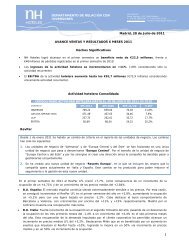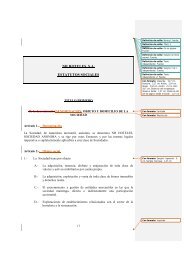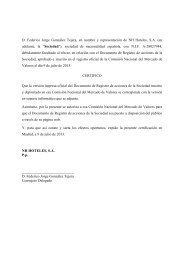Consolidated Financial Statements and Consolidated Management ...
Consolidated Financial Statements and Consolidated Management ...
Consolidated Financial Statements and Consolidated Management ...
You also want an ePaper? Increase the reach of your titles
YUMPU automatically turns print PDFs into web optimized ePapers that Google loves.
4.8. Inventories<br />
The criteria followed to value the different elements that comprise inventories are as follows:<br />
Real estate operations (through Sotogr<strong>and</strong>e, S.A.)<br />
All costs incurred are identified by area <strong>and</strong> product in order to determine the cost of each element at the moment it is sold. This method assigns to<br />
the cost of the sale a proportional part of the total value of the l<strong>and</strong> <strong>and</strong> of the development costs based on the percentage the square metres sold<br />
represents of the total square metres available for sale in each area.<br />
All l<strong>and</strong> <strong>and</strong> plots held for sale are classified under current assets though their construction <strong>and</strong> sale period may exceed one year.<br />
i) Undeveloped l<strong>and</strong>: Undeveloped l<strong>and</strong> is valued at original cost, which includes any legal expenses for deeds of sale, registration <strong>and</strong> any taxes not<br />
directly recoverable from the Inl<strong>and</strong> Revenue.<br />
ii) Developed l<strong>and</strong>: Developed l<strong>and</strong> is valued at cost or market value, whichever is lower. The cost mentioned above includes the cost of l<strong>and</strong>,<br />
development costs <strong>and</strong> the cost of technical projects. Taking into consideration the peculiar characteristics the Company’s business (development<br />
<strong>and</strong> sale of a property measuring approximately 16 million square metres over a period of approximately 50 years), the value of developed l<strong>and</strong><br />
includes the personnel expenses <strong>and</strong> overheads incurred by the technical department in connection with the development <strong>and</strong> design of the<br />
different projects. The personnel expenses <strong>and</strong> overheads directly attributable to such projects amounted to approximately 29,000 euros in 2011<br />
(21,000 euros in 2010).<br />
iii) Buildings constructed <strong>and</strong> under construction: These are valued at cost price, which includes the proportional part of the cost of l<strong>and</strong> <strong>and</strong><br />
infrastructures <strong>and</strong> any costs directly incurred in connection with the different promotions (projects, building licences, certifications of works,<br />
declaration of new works, registration at registry, etc.). The Group takes into account the market value <strong>and</strong> the term for realising the sales of its<br />
finished products, making the necessary value adjustments whenever needed.<br />
Hotel operations<br />
Catering edible products are valued at original cost or at realisation value, whichever is lower.<br />
4.9. Transactions <strong>and</strong> balances in foreign currency<br />
The Group’s functional currency is the euro. Consequently, any transactions in currencies other than the euro are considered as “foreign currency” <strong>and</strong> are<br />
booked according to the prevailing exchange rate on the date the transactions are performed.<br />
Cash assets <strong>and</strong> liabilities denominated in foreign currencies are converted into the functional currency at the prevailing exchange rate on the date of<br />
each consolidated balance sheet. Any gains or losses thus revealed are directly attributed to the consolidated comprehensive profit <strong>and</strong> loss statement.<br />
4.10. Classification of financial assets <strong>and</strong> debts into current <strong>and</strong> non-current<br />
In the consolidated balance sheet attached, financial assets <strong>and</strong> debts are classified on the basis of their maturity; that is to say, those whose maturity date<br />
is equivalent to or less than twelve months are classified as current <strong>and</strong> those whose maturity date exceeds such period as non-current.<br />
In this regard, mortgage loans connected with real estate inventories whose initial maturity date schedule includes dates at more than 12 months totalling<br />
7,468,000 euros, are classified as current liabilities (see Note 16).<br />
4.11. Income <strong>and</strong> expenses<br />
Income <strong>and</strong> expenses are booked on an accrual basis, i.e., when the real flow of goods <strong>and</strong> services they represent occurs irrespective of the moment when<br />
the monetary or financial flows arising from them arise.<br />
More specifically, income is calculated at the fair value of the consideration to be received <strong>and</strong> represents the amounts to be charged for the goods <strong>and</strong><br />
services delivered within the ordinary framework of operations, subtracting any discounts <strong>and</strong> taxes.<br />
Income <strong>and</strong> expenses arising from interest are accrued on the basis of a financial timing criterion depending on the outst<strong>and</strong>ing principal to be charged<br />
for or paid <strong>and</strong> the effective interest rate that applies.<br />
In accordance with IAS 18, the Group follows the criterion of booking sales of real estate under construction <strong>and</strong>, consequently, any profits from the same at<br />
the moment the significant risks <strong>and</strong> benefits of such real property are transferred to the buyer <strong>and</strong> the buyer has taken effective control over the property.<br />
As a general rule <strong>and</strong> following the principle of correlation between income <strong>and</strong> expenses, any commission fees for sales staff <strong>and</strong> others of a general<br />
nature (sales representatives, advertising, etc.) not specifically attributable to real estate developments, though solely connected to the same, incurred<br />
from the moment the developments are initiated up to the moment the sales are booked are entered into the books under the “Other current assets” item<br />
of the assets side of the consolidated balance sheet, so that they may be attributed to expenses at the moment the sales are booked, provided the margin<br />
from the sale agreements entered into pending entry into the books exceeds the amount of such costs at the end of each year.<br />
4.12. Official subsidies<br />
Group companies follow the criteria set out below to book official subsidies:<br />
- Non-reimbursable capital subsidies (connected with assets) are valued at the amount granted, booked as deferred income <strong>and</strong> attributed to results in<br />
proportion to the depreciation of the assets financed by such subsidies during the financial year.<br />
- Operating subsidies are booked as income at the moment of their accrual.<br />
4.13. Tax on profits<br />
The cost of the year’s tax on profits is calculated through the sum of the current tax resulting from applying the tax rate on the year’s taxable base <strong>and</strong> then<br />
applying any admissible tax write-offs plus any changes in deferred tax assets <strong>and</strong> liabilities.<br />
Deferred tax assets <strong>and</strong> liabilities include any temporary differences, being any amounts expected to be payable or recoverable due to differences<br />
between the book values of the assets <strong>and</strong> liabilities <strong>and</strong> their tax value, as well as any negative tax bases pending offsetting <strong>and</strong> any credits resulting from<br />
unapplied tax write-offs. Said amounts are booked by applying to the relevant temporary difference or credit the tax rate at which they are expected to<br />
be recovered or settled.<br />
In some countries, the tax rate varies depending on whether a transfer of assets is made. In these cases, the Group’s policy consists of applying the<br />
effective tax rate at which they are expected to be recovered or settled. In the opinion of the Directors of the Group, the deferred tax thus calculated covers<br />
the amount which may eventually be settled, if any, in the foregoing case.<br />
74<br />
REPORT ON THE CONSOLIDATED FINANCIAL STATEMENTS
















